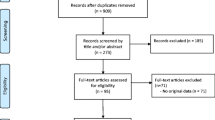Abstract
Postpartum urinary retention (PUR) is a clinically significant problem for women after delivery. Despite the large body of literature that covers this topic, PUR is not a clearly defined or well understood condition. The aim of this review article is to provide a better understanding of the risk factors and pathophysiology that contribute to the development of PUR. We provide a framework with which to evaluate and manage PUR. Meticulous attention to bladder care combined with early detection are key elements in minimizing PUR.
Similar content being viewed by others
References
Papers of particular interest, published recently, have been highlighted as: • Of importance
Yip S, Sahota D, Pang MW, et al. Postpartum urinary retention. Acta Obstet Gynecol Scand. 2004;83:881–91.
Carley ME, Early JM, Vasdev G, et al. Factors that are associated with clinically overt postpartum urinary retention after vaginal delivery. Am J Obstet Gynecol. 2002;187(2):430–3.
Saultz JW, Toffler WL, Shackles JY. Postpartum urinary retention. J Am Board Fam Pract. 1991;4:341–4.
Liang CC, Chang SD, Chang YL, et al. Postpartum urinary retention after cesarean delivery. Int J Gynecol Obstet. 2007;99:229–32.
Andolf E, Iosif CS, Jorgensen C, et al. Insidious urinary retention after vaginal delivery: prevalence and symptoms at follow-up in a population-based study. Gynecol Obstet Invest. 1994;38:51–3.
• Kekre A, Vijayanand S, Dasgupta R, et al. Postpartum urinary retention after vaginal delivery. Int J Gynecol Obstet. 2011;112:112–5. This is a recent study that points to operative vaginal delivery and labor longer than 700 minutes as being significant obstetric risk factors in the development of PUR.
Ching-Chung L, Shuenn-Dhy C, Ling-Hong T, et al. Postpartum urinary retention: assessment of contributing factors and long-term clinical impact. Aust NZ J Obstet Gynaecol. 2002;42:365–8.
Musselwhite KL, Faris P, Moore K, et al. Use of epidural anesthesia and the risk of acute postpartum urinary retention. Am J Obstet Gynecol. 2007;196:472.e1–5.
Yip SK, Brieger G, Hin LY, et al. Urinary retention in the postpartum period: the relationship between obstetric factors and the post- partum post-void residual bladder volume. Acta Obstetric Gynecol Scand. 1997;76:667–72.
Yip S, Sahota D, Pang M, et al. Screening test model using duration of labor for detection of postpartum urinary retention. Neurourol Urodyn. 2005;24:248–53.
Lieberman E, O’Dohoghue C. Unintended effects of epidural analgesia during labor: a systematic review. Am J Obstet Gynecol. 2002;186:S31–68.
Weissman A, Grisaru D, Peyser RM, et al. Postpartum surveillance of urinary retention by ultrasonography: The effect of epidural analgesia. Ultrasound Obstet Gynaecol. 1995;6:130–4.
Rizvi RM, Khan ZS, Khan Z. Diagnosis and management of postpartum urinary retention. Int J Obstet Gynecol. 2005;91(1):71–2.
Bennetts FA, Judd GE. Studies of the post-partum bladder. Am J Obstet Gynecol. 1941;42:419–27.
Glavind K, Bjork J. Incidence and treatment of urinary retention postpartum. Int Urogyn J. 2003;14:119–21.
Damaser MS, Broxton-King C, Ferguson C, et al. Functional and neuroanatomical effects of vaginal distention and pudendal nerve crush in the female rat. J Urol. 2003;170:1027–31.
Yip S, Sahota D, Chang AM. Determining the reliability of ultrasound measurements and the validity of the formulae for ultrasound estimation of postvoid residual bladder volume in postpartum women. Neurourol Urodyn. 2003;22(3):255–60.
Stallard S, Prescott S. Postoperative urinary retention in general surgical patients. Br J Surg. 1988;75:1141–3.
Yip S, Sahota D, Pang MW. Postpartum urinary retention. Obstet Gynecol. 2005;106(3):602–6.
Page G, Buntinx F, Hanssens M. Indwelling bladder catheterization as part of postoperative care for cesarean section (Protocol for Cochrane review). In: the Cochrane library, issue 3. Chichester, UK: Wiley;2004.
Burkhart FL, Porgers RF, Gibbs CE. Bladder capacity postpartum and catheterization. Obstet Gynecol. 1965;26:176–9.
Livne P, Kaplan B, Ovadia Y, et al. Prevention of post-hysterectomy urinary retention by alpha-adrenergic blocker. Acta Obstet Gynecol Scand. 1983;62:337–40.
Tammela T, Kontturi M, Kaar K, et al. Intravesical prostaglandin F2 for promoting bladder emptying after surgery for female stress incontinence. Br J Urol. 1987;60:43–6.
Jaschevatzky OE, Anderman S, Shalit A, et al. Prostaglandin F2 alpha for prevention of urinary retention after vaginal hysterectomy. Obstet Gynecol. 1985;66:244–7.
Burger D, Kappetein AP, Boutkan H, et al. Prevention of urinary retention after general surgery: a controlled trial of carbachol/diazepam versus alfusozine. J Am Coll Surg. 1997;185:234–6.
Hinman F. Editorial: postoperative overdistension of the bladder. Surg Gynecol Obstet. 1976;45:901–2.
Lee SNS, Lee CP, Tang OSF, et al. Postpartum urinary retention. Int J Gynecol Obstet. 1999;66:287–8.
Groutz A, Levin I, Gold R, et al. Protracted postpartum urinary retention: the importance of early diagnosis and timely intervention. Neurourol Urodyn. 2011;30:83–6.
Kulkarni R, Bradford WP, Forster SJ, et al. Chronic retention of urine following childbirth—a rare complication in the puerperium. Aust N Z J Obstet Gynecol. 1994;34(1):107–8.
Jeffery TJ, Thyer B, Tsokos N, et al. Chronic urinary retention postpartum. Aust N Z J Obstet Gynaecol. 1990;4:364–6.
Watson WJ. Prolonged postpartum urinary retention. Mil Med. 1991;156:502–3.
Groutz A, Gordon D, Wolman I, et al. Persistent postpartum urinary retention in contemporary obstetric practice. Definition, prevalence and clinical implications. J Reprod Med. 2001;46:44–8.
Yip S, Sahota D, Chang A, et al. Four year follow-up of woman who was diagnosed to have postpartum urinary retention. Am J Obstet Gynecol. 2002;187:648–52.
Disclosure
No potential conflicts of interest relevant to this article were reported.
Author information
Authors and Affiliations
Corresponding author
Rights and permissions
About this article
Cite this article
Mehta, S., Anger, J. Evaluation and Management of Postpartum Urinary Retention. Curr Bladder Dysfunct Rep 7, 260–263 (2012). https://doi.org/10.1007/s11884-012-0162-7
Published:
Issue Date:
DOI: https://doi.org/10.1007/s11884-012-0162-7



